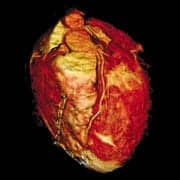 |
· Secret Agents
· Safe Handling of Radionuclides: The ’07 Update
Secret Agents
A product round-up of contrast agents on the market today
By Renee DiIulio
The ability to see inside the body with imaging techniques today is accomplished only partially with technology. Contrast agents play a significant role, helping to differentiate tissues and disease states. They are used in most modalities, including MRI, PET, SPECT, CT, and x-ray. The unique properties of each agent can influence its use with various modalities or in various applications. Here, Medical Imaging highlights some of the newest and most popular agents on the market.
Bayer Healthcare

|
| Ultravist from Bayer Healthcare |
Through its pharmaceuticals division, which merged with Berlex Laboratories Inc last year, Bayer Healthcare, Wayne, NJ, offers three contrast agents.
The MR contrast agent Magnevist (gadopentetate dimeglumine)* was introduced in 1988 and has been used in more than 70 million MR procedures worldwide. It has broad applications with adult and pediatric indications in the central nervous system (CNS), head, neck, and body, excluding cardio applications. The agent is unique in that it does not interfere with serum calcium measurements. It is available in 50 mL and 100 mL pharmacy bulk packages with 24-hour time of use.
Feridex IV (ferumoxides injectable solution) is intended specifically for use in liver MR imaging at any magnet strength. The superparamagnetic oxide, introduced in 1996, is a negative contrast agent that is taken up by reticulo-endothelial system (RES) cells in the liver; tissues with decreased RES function retain their signal intensity. In this way, the agent helps to differentiate normal and abnormal liver tissue, enabling the clinician to see new and smaller lesions with more contrast.
Ultravist (iopromide) is a radiological contrast agent that has been proven safe in all major intra-arterial (IA) and intravenous (IV) indications. It was introduced in the United States in 1995 and has been administered clinically to more than 100 million patients. The agent features low osmolality and is well-tolerated by patients. Ultravist is available in four concentrations, ranging from 150 mgI/mL to 370 mgI/mL; the vials are color-coded and available in a 500 mL pharmacy bulk package.
Bracco Diagnostics

|
| Isovue from Bracco Diagnostics |
One of the most popular products out of roughly 25 contrast agents available from Bracco Diagnostics, Princeton, NJ, is Isovue (iopamidol injection). The nonionic contrast agent is indicated for a broad range of radiological procedures, including angiography, contrast-enhanced CT (CECT) head and body imaging, tumor detection, and nonneoplastic lesions. The medium was introduced in 1986 and has been administered more than 250 million times worldwide. The product is available in a range of concentrations and packaging options, including a multipack.
MRI agent MultiHance is another popular Bracco product that has been on the US market since 2004. It features nearly twice the relaxivity of other gadolinium-based agents,* which contributes to improved visualization. The medium is indicated for use in the CNS of adults and aids visualization of lesions with abnormal blood-brain barrier and abnormal vascularity.
ProHance (gadoteridol) was Bracco’s first gadolinium-based MR agent* and was launched in the United States in 1992; it has been administered in more than 8 million doses. According to the company, it has the highest stability and lowest osmolality of all agents in its class. The medium also can be used to view lesions in the head and neck as well as abnormal vascularity in the brain, spine, and associated tissues.
Specific PET contrast agents include CardioGen-82 for use in evaluating coronary artery disease; Choletec, for hepatobiliary imaging; Iodotope I-131 to treat thyroid disease; and MDP-Bracco, to image bones.

|
| Omnipaque from GE Healthcare |
GE Healthcare
GE Healthcare Medical Diagnostics, Prince-ton, NJ, offers seven contrast agents: Ceretec, Metastron, Myoview, Omnipaque, Omni-scan, Optison, and Visipaque.
Omnipaque (iohexol) features a range of uses in adult and pediatric patients as a contrast agent for x-ray, from intravascular diagnostic procedures to spinal cord imaging and body cavity procedures. The nonionic, low osmolality medium has been administered to more than 250 million patients globally and has been in use in the United States since 1985. Concentrations range from 140 mgI/mL to 350 mgI/mL and packaging is equally broad.
Visipaque (iodixanol) is an injectible isomolar contrast agent indicated for use in CECT imaging of the head and body. The medium is approved for use in patients 1 year old and up and was first introduced in 1996.
Omniscan (gadodiamide),*launched in 1993, also can be used in pediatric patients; the contrast medium has multiple indications for use with MR imaging. These include the visualization of lesions with abnormal vascularity in the brain, spine, and associated tissues; contrast enhancement of CNS to detect lesions of the brain, spinal cord, and associated tissues; and the visualization of lesions with abnormal vascularity within the thoracic (noncardiac), abdominal, and pelvic cavities and the retroperitoneal space. Its low viscosity eases delivery, permitting fine gauge needles.
Nuclear imaging agents include Ceretec and Myoview. Ceretec has two indications: visualization of cerebral blood flow, and labeling of white blood cells in the localization of infection and inflammation sites. Myoview helps to diagnose regions of reversible myocardial ischemia.
Guerbet
Guerbet LLC, Bloomington, Ind, offers only one contrast agent in the United States, although its portfolio is expanded elsewhere. Oxilan (ioxilan) injection for x-ray diagnostic and interventional procedures is a low-viscosity contrast agent with a unique molecular structure, which makes it easier to eliminate from the body.
“It has the lowest osmolality and one of the lowest viscosities of all nonionic monomers in the United States,” said product manager Inga Paegle. Its unique molecular structure consists of a hydrophobic region masked by a hydrophilic group. The hydrophobic region helps achieve lower osmolality at diagnostically useful concentrations through molecular aggregation; the hydrophilic group helps reduce binding with other molecular structures.
Intravenous indications include CECT head, CECT body, and excretory urography; IA indications suggest cerebral arteriography, coronary arteriography/left ventriculography, aortography and selective visceral angiography, and peripheral arteriography.
Mallinckrodt
Mallinckrodt Inc, Hazelwood, Mo, a division of Tyco Healthcare, offers more than 230 contrast agents, media delivery systems, guide wires, and infusion pumps. The agents span all modalities.
MR contrast media include the nonionic, low viscosity, low osmolality OptiMark (gadoversetamide injection).* Launched in 1999, it is approved for use by the FDA with power injectors.
|
*For an update on the current state of affairs regarding gadolinium-based contrast agents and the emergence of nephrogenic systemic fibrosis, read “Controversy Mounts Over Gadolinium-Based Contrast Agents” in the April 10 edition of the ADVISOR |
 |
GastroMARK (ferumoxsil oral suspension) is a negative contrast agent intended for gastrointestinal use and introduced in 1999. With its use, the stomach and duodenum appear darker.
X-ray contrast media include Optiray, which is well tolerated and indicated for a variety of uses, including both adult and pediatric exams. The low osmolar, low viscosity nonionic medium is available in a variety of concentrations and packaging.
Conray (iothalamate meglumine injection) is an ionic, high osmolar contrast media agent for use in organ and tissue enhancement in CT, x-ray, and fluoroscopy. The medium is available in a variety of volumes and is packaged in glass vials.
Renee DiIulio is a contributing writer for Medical Imaging. For more information, contact .
Safe Handling of Radionuclides: The ’07 Update
By Cat Vasko
Over the years, the handling of radiopharmaceuticals has become heavily regulated by both federal and state agencies—and as the field of nuclear medicine becomes increasingly eminent, the attention will undoubtedly increase.
“In terms of the safety and hazard issues involved in handling radioactive materials, as long as you know what you’re doing, you’re well-trained, and you have the right equipment, it’s not something that’s dangerous to the operator,” explained Paul Knapp of Cardinal Health Nuclear Pharmacy Services, Akron, Ohio. “However, if you take your eye off the ball or try to take shortcuts, it can be.”
Len Smith of Perkin Elmer Inc, Waltham, Mass, concurred: “It’s pretty rare in this sector [to see an incident involving handling]. But you do have to keep your eye—all the time—on how much exposure a person’s getting. You must keep on monitoring and measuring and making adjustments. It’s quite labor intensive.”
Knapp noted, “The basic tenet of radiation safety is to make an attempt to keep your exposure to the radioactive material as low as reasonably achievable—that’s where we get the term ALARA. We could all wear lead suits all the time and reduce our exposures to zero, I guess, but it’s not really reasonable to think we would do that. It’s theoretically possible, but not practical. So there’s a bit of a compromise there.”
Smith said that a common hazard can arise from badge calibration—that is to say, a handler being unaware of the particulars of the badge that he or she is using to measure personal exposure. “There can be accumulating exposure to the hands that needs to be controlled,” he said, “and that would be the most prominent dose control issue.”
What is required, according to Smith, is an excellent understanding of how the radiation fields are configured. “It’s not just a case of taking one quick measurement and then knowing that you have a radiation field,” he noted. “You need to know how it spreads and how localized it is. When you’re doing dispensing, your hands are very close to the source; if you move your hands just slightly, the actual exposure can change dramatically.”
The radiation exposure measured by a handler’s badge, which is usually placed on top of the hand, could be “quite different” from the exposure to the handler’s fingertips, Smith said. “There have been problems in the past where regulators were concerned that people might have been getting more exposure than what the badges were actually measuring. Now, people usually will operate so that even if the badge is monitoring less than the maximum exposure, they’ll know that it’s less, and they’ll operate at a limit. It’s a very conservative approach, but it’s better to be safe than sorry.”

|
Knapp noted three main components of radiation safety: time, distance, and shielding. “The shorter the amount of time that you’re handling the material, the better,” he said. “The farther away you keep the material from you, the better. And shielding is just what it sounds like—keep a bunch of lead between you and what you’re handling. Those three, combined with experience and training, are what keep our people safe.”
Knapp said that one of the most onerous obstacles a nuclear medicine department could face does not come from radiopharmaceuticals, but rather from the conflicting desires of agencies regulating radiopharmaceuticals. “We run into situations where certain state board of pharmacy regulations don’t adequately address what nuclear pharmacy does, so we need to work with them to develop specific nuclear regulations that carve us out from the rest of pharmacy practice,” he said. “The pharmacy boards don’t care if the drugs are radioactive—they just care that they’re drugs. The folks who regulate radioactive material really don’t care that it’s drugs—they just care that it’s radioactive material. Sometimes, we need to work with regulators to come up with a compromise, or we take it upon ourselves to interpret regulations that are rather vague in such a way that we can still comply with them and do what we do.”
The upside? Hormesis—the process by which continual exposure to low levels of radiation actually boosts the body’s immune system. “We evolved in a radioactive environment,” Knapp explained. “The biological systems on this planet were designed with that taken into account. Your immune system is designed to deal with a certain amount of mutations that may or may not result from inherent radioactivity in the environment. If you gently increase the amount of radiation that you’re chronically exposed to, studies suggest you can ramp up your immune system.”
Cat Vasko is associate editor of Medical Imaging. For more information, contact .





